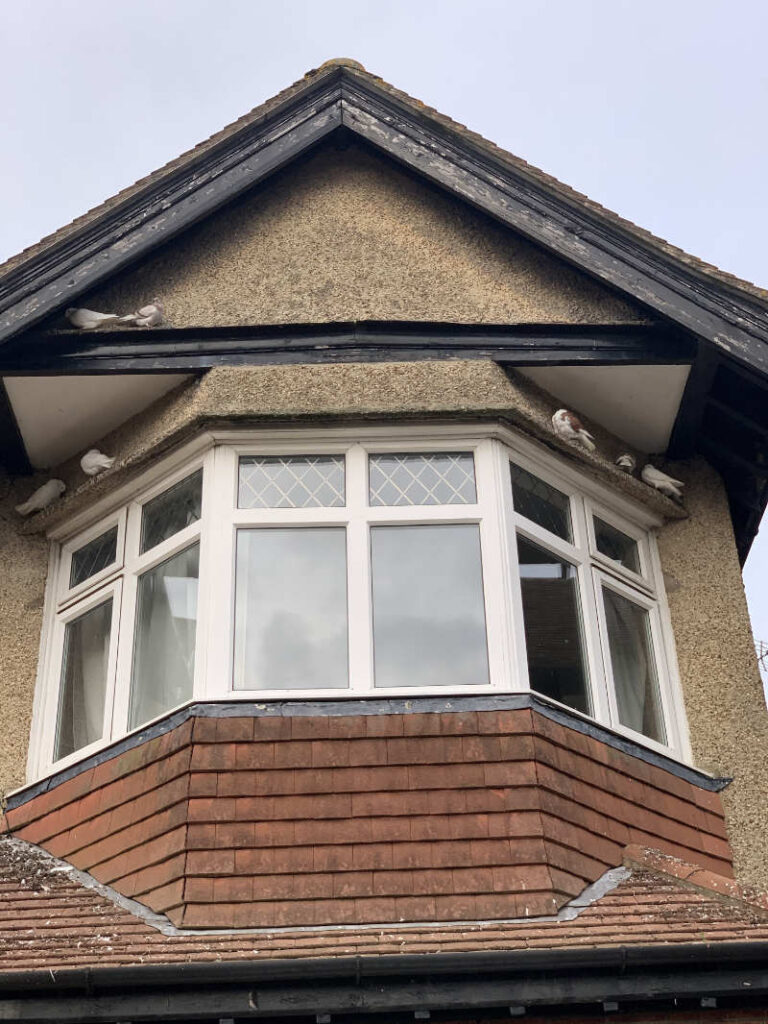Pebbledash or Roughcast?
 Both processes usually involve gravel or shingle rather than whole pebbles such as you might find on the beach. It’s easier to just say stones, but it can be pea shingle or gravel, often including small or broken sea shells.
Both processes usually involve gravel or shingle rather than whole pebbles such as you might find on the beach. It’s easier to just say stones, but it can be pea shingle or gravel, often including small or broken sea shells.
Pebbledash
This is where the stones are thrown (cast) at fresh render so they stick to it.
Roughcast
This is a similar process, but the stones are mixed with mortar before being cast. This results in a textured mortar finish rather than the stones actually showing over the render.
Either can be overpainted (and we see both examples in the Triangle) however roughcast is easier to paint as it starts off as a smoother finish, depending on whether the stones are smooth or broken with sharp edges. When you paint over pebbledash several more coats may be required before all air pockets can be eliminated and a smoother appearance achieved. Some decorators may prefer to spray, especially if large areas are involved.
As you can see from the article below, when repairing or patching up pebbledash it can be very tricky to get a consistent match with the existing, due to matching render colour, pebble colour and size, and taking weathering into account. It may be far easier to overpaint, however you will need planning permission to paint over bare pebbledash.
Conservation & Repair of Pebbledash
From an article by Jonathan Taylor originally published in The Building Conservation Directory 2009. A full version of the article is available at ’
The repair of Edwardian pebbledash and roughcast is still a relatively new area for conservators. The standard solution to cracks and coat separation (either the outer coat or the base coat from the substrate) is to hack back to sound material, leaving edges slightly undercut where possible to improve the key. Tapping with a wooden implement such as the handle of a chisel will help to identify sound areas. Brickwork joints are then raked back to provide a key for the new mortar which is applied in two coats to match the existing.
At Port Sunlight, conservation officers at Wirral Council recommend that, for a moderately strong and porous background, a typical mix for dubbing out and the undercoats would be Portland cement, lime (hydrated high calcium lime) and sand, in the proportions 1:1:6 by volume. The mix for finishing coats would be cement, lime and well graded sand (to BS 1199), in the proportions 1:2:9 by volume.

For the pebbledash, stone which has been selected to match the original in size, colour and type, should be dashed on evenly using a scoop while the topcoat is still soft and then firmly tamped into the render to give an even-textured appearance over the whole wall face.
Where unpainted pebbledash is concerned, the appearance depends on the colour and texture of the mortar, the ratio of stones to mortar, and the appearance of the stones themselves. It is therefore difficult to achieve a good match, and repairs are often highly visible.
Understandably, owners often find a patchwork effect difficult to accept, and as a result there is a tendency to overpaint repaired pebbledash, substantially changing the character of the building and its historic integrity. Pebbledash repairs must therefore be carried out by skilled conservators and backed up by mortar analysis. In some cases it may be possible to avoid repairs by injecting with a fine hydraulic grout or other consolidant.
Where unpainted pebbledash is suffering from surface cracks, layers of dirt may hide some cracks and cleaning may be necessary. The selection of the most appropriate method of cleaning will depend on the nature of the dirt layer, but generally the use of solvents and degreasants in conjunction with gentle washing are likely to be the least damaging, provided that care is taken to avoid saturating the material.
Edwardian roughcast, since it is based on hard cement-rich mortars, displays much the same problems as pebbledash. However, it is usually painted over, and so repairs are more easily hidden.
Before carrying out any repair, it is important to consider the cause of the problem. If the original detailing and the original materials are at fault, repairing as found may be inadvisable. For example, is a flashing required to prevent moisture ingress? Or is the use of a dense cement-rich render itself causing the problem?
There are many cases where really important historic buildings have been treated with a cement roughcast or pebbledash in the 19th or 20th century which is now causing problems. Damp finds its way in through cracks and is then trapped, causing the underlying structure to deteriorate.
In a situation such as this, where a modern cement render is obviously inappropriate, the natural reaction would be to replace the render with a softer and more porous lime-based alternative that can allow the building to breathe.
However, cement renders tend to adhere to the substrate extremely well, and separating the two can result in the loss of the underlying face, causing more damage than it prevents. It is therefore essential to start with a test panel to determine whether complete removal is a practical solution. There are many cases, from medieval church towers to fine Georgian terraces, where the decision has been taken by conservators to leave a cement-based render in situ, and to maintain it as a waterproof coat rather than risk removing it.
Pebbledash and cement render have been widely criticised in recent decades for being ugly, too hard, impervious and highly damaging to historic fabric. However, as this article shows, they are an important feature in the architectural vocabulary of the Edwardian period, and original examples deserve better understanding and careful conservation.

 Portswood Broadway Busgate Latest!
Portswood Broadway Busgate Latest!